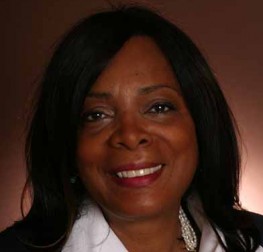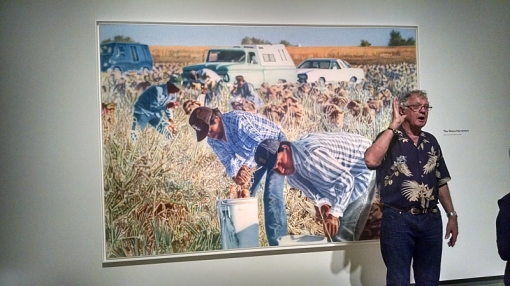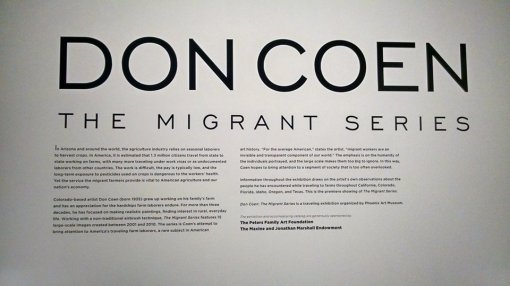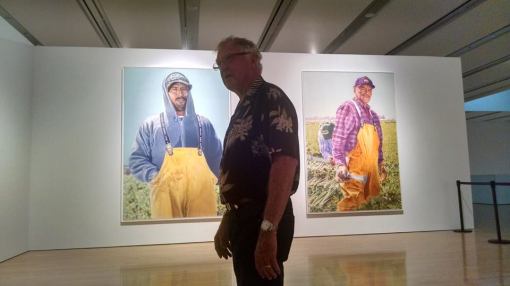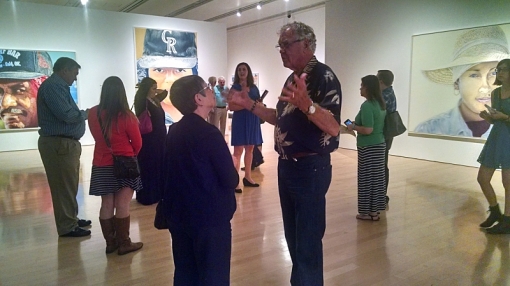-

-
Andy Warhol, Cow, 1976
-

-
Andy Warhol, Queen Elizabeth II of the United Kingdom, 1985
A cow and a queen came to an art museum. Much to the dismay of royalty-lovers everywhere, the venue displayed portraits of the Mum and the moo in equally beautiful ways. And that decision—and other choices made by artist Andy Warhol—either transformed or destroyed art, depending on whom you ask.
“Andy Warhol: Portraits” opens this Wednesday, March 4, at the Phoenix Art Museum, and the show’s vibrant, warm embrace confirms that the PAM curators are firmly in the “transform” camp. Warhol’s work and his influence are stunningly explored. And though Warhol had a gaze and an aesthetic that was famously straightforward and that kept viewers at a remove, the Phoenix show manages to humanize him in multiple ways.
(Before I get started: If you’re wishing this post had some legal-ish content, simply recall that Warhol’s work and legacy have been marked by litigiousness. The lawsuits have ranged among the authenticity of his prints; to whether a Farrah Fawcett print over a bed belonged to her ex-lover Ryan O’Neal, who slept in that same bed (or belonged to the University of Texas, which never slept with her but was bequeathed her possessions); to the slippery topic of trademark ownership in the iconic banana design on the 1967 album cover of the band The Velvet Underground and Nico. Enjoy your tangential reading, if you must. But the rest of you? Let’s get back to the terrific show at the Phoenix Art Museum.)
Almost all the works on display come from The Andy Warhol Museum in Pittsburgh (one beautiful exception on display from the Phoenix Art Museum’s own collection is a series of 100 multicolored silkscreens in cube form, all gathered in a box). At a February 27 media tour, Amada Cruz, the recently arrived Sybil Harrington Director at Phoenix Art Museum, describes the artist’s significance. A widely talented individual, Warhol used painting, photography, filmmaking, magazine publishing, music producing, and even the artistic “event” as moments of cultural inspiration. He also was the first modern artist “to embrace commerce and meld the high and the low effortlessly.” Hence, the queen and the cow.

Andy Warhol, Portraits of the Artists from the Portfolio Ten From Leo Castelli, 1967.
“It’s a portraiture show,” Cruz reminds us, “but not in the mold that you traditionally think.”
The museum’s Dr. Jerry Smith, curator of American and European art to 1950 and art of the American West (could museum titles get longer, please?), describes the path Warhol took, as well as his early-onset nervous system disorder that kept him inside and drawn to a lifelong love of movies. Later in life, the commercial illustrator became highly attuned to what customers wanted. Where other artists might disdain a focus on “brand,” he welcomed it. Intrigued by celebrity, he forged an identity marked as much by his circle of “superstars” as by his own wry involvement in that very circle.

Curator Dr. Jerry Smith in front of a self-portrait of Andy Warhol.
To see more images of works that appear in the show, go to the Arizona Attorney Magazine Facebook page here.
Warhol’s charming persona is everywhere in this show. It’s visible in an early letter the young Andy Warhola (his original family name) received from Shirley Temple in response to his request for an autograph. It’s present in the affection he clearly felt for those who were his subjects, whether Marilyn Monroe, Joan Crawford, or more minor figures lost to the sands of time. And his own personality is with us when we read the image captions, wisely leavened with quotations from Warhol’s own daily journal.

A display of photos of Andy Warhol as a boy and young man.
The artist’s own life is also present in a display of photos of him as a boy and young man. Gathered together in a glass-covered table in the exhibit’s heart, they are worth seeking out.

Andy Warhol, Jackie, 1964.
As Dr. Smith speaks, the mind drifts, Warhol-like, to recent Web events (the newest frontier). What would the bewigged artist have thought of a battle over a dress color, or a nation transfixed by video of escaping llamas?
Smith beams and muses that Warhol would have loved the week’s llama news.
“He would have eaten it up,” Smith says. “There is so much in today’s culture that speaks to who Andy Warhol was.”
(Unsure? Head over to this Slate story that Warhol himself would have appreciated: No, culture-warriors, two llamas and a dress don’t indicate a media #fail. Quite the opposite.)
Smith even offers that Warhol “would have invented Perez Hilton,” if he could have.
-

-
Andy Warhol, Marilyn, ca. 1967
-

-
Andy Warhol, Skull, 1976
That playful attitude clearly informed the gallery’s design, which includes large and eye-catching color-blocks. The placement of artworks on the wall, says Smith, is meant to communicate with the artist. Just as Warhol was unconcerned about perfect color registration in the development of his photographs, museum staff did not seek to align pieces exactly along the color-blocks’ edges. The result is a comfortable irregularity, which leads viewers to pause and reassess as colors mix and separate.
-

-
Andy Warhol Portraits exhibit, Phoenix Art Museum, March 4 – June 21, 2015.
-

-
Andy Warhol Portraits exhibit, Phoenix Art Museum, March 4 – June 21, 2015.
One piece that benefits from darkness rather than color is Warhol’s 15-foot-long Last Supper image. It is set off via blacklight in its own light-emptied space. Stroll in and let your eyes adjust to see what Warhol intended.

Andy Warhol, The Last Supper, 1986
A room with three Warhol videos will attract most viewers for a few moments. (True-believers will linger longer.)
Another room demands viewer interaction. “Silver Clouds” offers inflated Mylar rectangles that attendees are free to send soaring (but be assured that “spiking” the clouds will get you a museum-guard reprimand). That installation is bound to become an exhibit favorite.

Andy Warhol, Silver Clouds installation, 1994 (Museum staffer Chelsea Ellsworth demonstrates)
In the same way, a few elements toward the end of the exhibit prod us toward participation.
A “screen test” area provides a camera and a backdrop for your own four-minute silent movie. You can opt to have a link of your work emailed to you, which you can share with all of your circles (including, perhaps, Perez Hilton).
-

-
Camera and lighting for personal screen test area, Phoenix Art Museum, Andy Warhol: Portraits
-

-
Personal screen test area, Phoenix Art Museum, Andy Warhol: Portraits
Next to the screen test is a test of your willingness to engage the macabre. A wall-mounted monitor streams the 24-hour webcam trained on Warhol’s Pittsburgh grave. Not much may occur there, but I’ve been told that his birth and death days may offer must-see TV (picture soup-can stacks, etc.). I leave you to research that. (You can see the grave-cam here; it looks cold.)

Keep an eye on Warhol’s grave 24/7.
Near the screen test area, a wallpaper-adorned selfie station offers the one place in the exhibit that such a thing is permitted. Of course, selfies are matched perfectly with the self-referential artist. As Smith said with a smile, if Warhol were alive today, they’d probably be called “Andys.”
I must admit that a selfie hadn’t occurred to me, but the written prohibition that the media received (and that applies to the public) made me chuckle. To its credit, the Phoenix Art Museum did not devise this rule; it was crafted by the Warhol Museum itself. I watched the cemetery monitor closely to see if the artist was turning over in his grave at such a non-Warhol requirement. (Perhaps we can be hopeful that the Warhol Museum folks are not tone-deaf but are simply punking us. In either case, Warhol is laughing somewhere.)

No selfies in much of the Warhol exhibit (even if you look fabulous!).
A final element of the show requires mention. Although most all museum shows these days have a requisite joined-at-the-hip gift shop with related and unmemorable items, the Warhol shop is brilliantly and artistically perfect in its placement and item selection (“curation,” could we say?).
-

-
Shopping experience at end of the Warhol exhibition, Phoenix Art Museum.
-

-
Shopping experience at end of the Warhol exhibition, Phoenix Art Museum.
I have seen and strolled the museum’s Warhol gift shop. My uneducated opinion? They’re gonna make bank.
Warhol, of course, loved to explore the intersection of art and commerce. So the museum’s having the show flow into the store surprises and pleases rather than disturbs the viewer. And the bald greeting—“SHOP”—makes the Warhol-lover smile.
Dr. Smith told me that the museum sought to purchase the rights to an image of the artist actually shopping. Unable to secure those rights, they opted instead for the mannequin-cum-wig and the simple word.
As a public service (in this entirely noncommercial story), I share with you the great artist strolling an aisle, a superstar in a supermarket.

Yes, Andy Warhol shopped too (even for soon-to-be-iconic Brillo pads).
The show opens Wednesday, March 4, and runs through June 21, 2015. You will want to spend far longer than the Warhol-famous 15 minutes to commune with his pieces.
If you have a few more seconds, my Vines from the media tour are here, here and here.
Exhibits related to the Warhol show include films and installations, some with Arizona ties (and some are Rated X). Read about them here.
To see more images of works that appear in the show, go to the Arizona Attorney Magazine Facebook page here.






















